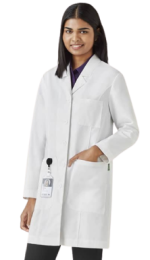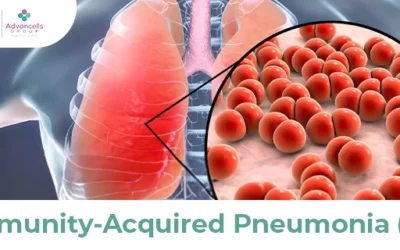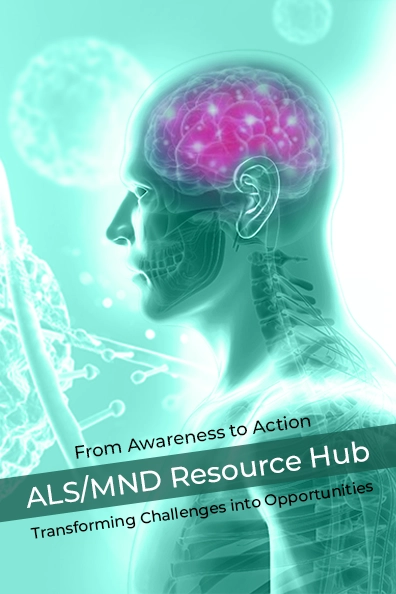Harnessing Regenerative Potential of Stem Cell Therapy for COPD
Chronic Obstructive Pulmonary Disease (COPD), is one of the leading public health challenges globally. Although it is both preventable and treatable, many of us continue to suffer because of it -often prematurely.
Promoting early diagnosis, encouraging healthy lifestyle, and raising awareness about advances in regenerative medicine as a promising treatment modality, can significantly reduce the burden of this chronic condition.
About Chronic Obstructive Lung Disorders (COPD)
COPD is extremely complicated in terms of its pathogenicity, which is mainly associated with airway inflammation and destruction. The condition is triggered by many harmful particles present in the air, like dust, fumes, as well as pollution. Cigarette smoke is noted as one of the most common triggers. When these irritants enter the lungs, they generate reactive oxygen species. These free radicals sparks an inflammatory response, leading to over-inflamed lungs, and damaged air sacs. Progressively, it affects rhythmic expansion and contraction of lungs, making breathing difficult, due to lack of sufficient oxygen.
What’s it like living with COPD?
Living with Chronic Obstructive Pulmonary Disease can significantly impact the quality of life. Mornings are often marked by breathlessness, and unusual fatigue due to overnight mucus buildup. Even simple routine tasks are physically exhausting, such as showering, getting dressed or even walking short distances. In later stages, a person can be emotionally stressed and anxious due to unpredictable flare-ups and breathing challenges. If left unmanaged for a longer period of time, it may gradually affect other major organs of the body due to reduced oxygen levels.
Current treatment for COPD primarily focuses on symptomatic relief
Dealing with the COPD unpredictability
For many living with chronic COPD, it may be like an unpredictable companion making its presence felt quiet suddenly. A person may one day wake up with great enthusiasm, breathing easy, and doing all tasks promptly; while the next morning he may struggle to do even simple jobs. Studies have also reported higher prevalence of depression and anxiety in people struggling with COPD.
So, if you want to get rid of this roller coaster life with both physical as well as emotional challenges; you need to act quick!
Choosing Technology over Conventional Modality
People with chronic COPD are often prescribed steroids and bronchodilators for the symptomatic management like ease breathing, reduce flare ups, etc. However, these strategies do not reverse, heal or repair any underlying tissue damage; and the disease continues to progress over the time.
Additionally, a lot of rehab programmes are suggested to improve breathing efficiency, build more stamina; but the objectives are often supportive and not curative. Thanks to technological advancements, it is now possible to improve our condition. All you have to do is take the first step towards a healthier future! Call us to know how? +91-9654321400
Regenerative Medicine Advancements: Your personalized Therapist
Amidst the innovative solutions, Stem Cell Therapy for COPD has emerged as a promising breakthrough. It induces functional recovery and improves breathing capacity by modulating the pathways behind the disorder. The cellular regeneration ability offered by stem cells offers them an advantage over conventional treatments. A personalized approach combining stem cells and exosomes has been proven to be a boon for effective reversal of the conditions.
A comprehensive analysis of 11 clinical studies completed globally, involving over 371 COPD patients revealed significant improvement in the exercise capacity and stamina. These end points were measured with the help of 6 minute walk tests, with an average increase of about 52 meters. These studies also reported favourable safety profiles, without any adverse events. (Please call to get the details about the study)
Meta-analysis of combinational approach involving both MSCs and MSC-derived exosomes confirmed improved lung functions and reduced inflammation; evaluated through marker tests. The properties are making exosomes, a potential adjunct to stem cell therapy in treating COPD.
Diagnosis
The following tests are used for diagnosing COPD:
Spirometry: It is the most common pulmonary function test (PFT), which measures the functional capacity of the lungs by evaluating the amount of air that flows in them. The patient is connected to the device and asked to inhale and exhale. The amount of air and speed of inhalation/exhalation offer an estimate of lung function. The procedure is repeated after administering a bronchodilator.
Radiography: It includes chest X-ray and CT scan. Hyperinflation, thickening of bronchial tubes and flattening of the diaphragm are indicators of COPD diagnosed by these techniques. A CT scan is more beneficial for lung cancer and surgical treatments.
Blood Test: Complete blood cell count evaluates the presence of infections, anemia and other such causes of COPD.
6-minute Walk Test: This test assesses the functional capacity of lungs by determining the amount of distance a patient walks in 6 minutes over a flat and straight surface with a maximum distance of 100 feet.
Early Signs & Symptoms of COPD / Lung Disease
The common COPD symptoms include:
- Difficulty in breathing
- Frequent coughing
- Easily fatigued
- Sputum production
- Tightness in the chest
- Wheezing (high-pitched whistling sound during breathing)
- Pursed lip breathing
- Rounded bulging chest
- Bluish discolouration in the skin and fingernails
- Enlargement of the tips of fingers and toes
- Increased curvature of nails
- Muscle wasting
- Prolonged expiration time
Available Types of COPD / Lungs Disorder
The types of COPD can be broadly classified based on their root mechanisms into the following:
Emphysema: It damages lung structure, resulting in diminished lung elasticity and breathing capacity.
Chronic Bronchitis: The risk factors trigger inflammation, leading to excess mucus secretion and subsequent airway blockage.
In 1998, the National Heart, Lung, and Blood Institute (NHLBI), together with the World Health Organisation (WHO), established the GOLD Initiative for Chronic Obstructive Lung Disease (GOLD). GOLD has updated the categories of COPD based on FEV1 (amount of air a person can forcibly exhale in 1s) and the severity of symptoms:
Group A: Mild symptoms, FEV1 ≥ 80%, no history of chronic flare-up, no need for hospitalization.
Group B: Mild symptoms, FEV1 50-79%, no history of chronic flare-up, no need for hospitalization.
Group C: Mild symptoms, FEV1 30-49%, history of chronic flare-up ≥2 times, hospitalized at least once.
Group D: Severe symptoms, FEV1 < 30%, history of chronic flare-up ≥2 times, hospitalized at least once.
What Causes COPD?
The factors that increase the risk of COPD:
- Age
- Infections
- Exposure to harmful particles or gases
- Air pollution
- Smoking
- Occupational exposure to harmful particles
- Genetic disorders such as alpha-1 antitrypsin deficiency
All these risk factors trigger inflammation, oxidative stress, and enzymatic imbalance, which results in:
- Loss of elasticity of airways or air sacs, hindering their capacity to expand/contract for airflow
- Inflammation hardens the airway, which restricts airflow
- Excessive phlegm/mucus production by airway cells blocks the airway
- Air gets trapped in the air sacs, which can hyperinflate lungs and cause difficulty in exhaling fully.
- Lung damage slowly increases, and breathing ability declines over time.
Available Treatments for COPD?
The COPD treatment options manage symptoms and recommend lifestyle modifications that reduce the risk of aggravating the condition.
It has prompted the search and development of novel treatment options. With their unique properties, stem cells have been rising as the effective treatment alternative that can promote tissue repair and regeneration. Therefore, the scientific community has employed stem cell therapy for chronic lung diseases and has demonstrated the following mechanisms for treating the disorder.
- Stem cells increase the levels of growth factors EGF, HGF, VEGF, etc., and enhance the proliferation of lung airway cells.
- These cells express α1-6, αV, and β1-4, ICAM-1, ICAM-2, VCAM-1, CD72, and CD58, which modulate T lymphocyte response.
- They also reprogram the macrophages to release IL-10, which inhibits the neutrophil-mediated tissue damage.
- Stem cells can secrete anti-inflammatory cytokines and factors, IL-10, TGF-β, and PGE2, while decreasing the production of pro-inflammatory cytokines.
- They also diminish the generation of profibrotic cytokines IL-1β, TGFβ, VEGF, IL-6, TNFα, MIP, etc.
- These cells also control oxidative damage via restoration of Hmox-1, GST, and Nrf2.
- Stem cell transplant for COPD can transform into lung-specific cell types that can replace lost or damaged cells. It contributes to the regeneration of lung structures and promotes functional recovery.
Stem cell-based regenerative medicine for respiratory disorders has thus gained widespread interest to restore functions and improve quality of life.
Frequently Asked Questions
Q1. How is stem cell treatment for COPD better than the available therapies?
Current treatment modalities only provide relief from the symptoms without treating the pathways behind the disorder or providing any functional recovery. On the other hand, stem cell therapy can improve lung function by targeting the mechanisms of COPD and inducing regeneration.
Q2. Is the stem cell treatment for COPD safe?
The clinical trials have reported that no adverse event occurred after stem cell treatment. The therapy was well-tolerated and caused only minimal complications, such as fever, which are manageable. It implies that stem cell treatment is safe.
Q3. Is the stem cell treatment procedure for COPD painful?
The procedure for stem cell treatment in COPD uses intravenous infusion. It is a non-surgical, minimally invasive procedure that causes negligible pain.
Q4. How many sessions of stem cell treatment for COPD are required?
The number of sessions for stem cell treatment varies with individuals, disorder severity, comorbidities, age, etc. Therefore, a defined number of sessions can be outlined without the details of the person’s medical history.
Q5. Why choose stem cell therapy for lungs in India?
India is the amalgamation of advanced technology, top-notch facilities, and clinical expertise. And all of this is available at a fraction of cost incurred in other destinations. Therefore, numerous people prefer stem cell therapy for COPD in India.
What can you expect?
- Improved lung function
- Decrease in severity of the disorder
- Reduction in inflammation
- Slowing or halting of disease progression
- Improved quality of life
Advantages of Allogeneic Umbilical Cord Tissue-Derived Stem Cells
 Abundant supply of cells
Abundant supply of cells Age 0 cells with higher regenerative potential
Age 0 cells with higher regenerative potential Low risk of immune rejection
Low risk of immune rejection
 Clinical Assessment
Clinical Assessment Physical Examination.
Physical Examination. Stem Cell Infusion
Stem Cell Infusion Post Treatment Evaluation
Post Treatment Evaluation Supportive Therapy Sessions
Supportive Therapy SessionsSupportive Sessions Beyond Stem Cell Therapy

Cell Regeneration
Stem cells transform into airway cells and also induce the proliferation of lung cells to repair the damaged tissue.

Alleviate Inflammation
Inflammation is a key pathway in COPD, but stem cells control the levels of inflammatory mediators, suppressing inflammation.

Reduce Lung Fibrosis
Stem cells decrease the expression of fibrotic mediators, which reduces lung damage.

Mitigate Oxidative Stress
Reactive oxygen species can damage cellular components. Stem cells increase the expression of antioxidants.
Consult Today
Get your treatment booked today, with our advanced secretome complex is packed with anti-inflammatory cytokines, growth factors and secretary vesicles that induce protective action against damaging neurons.

29 yr, MADHUSMITA PATRO Treated For ILD Through…
Name : MADHUSMITA PATRO Age : 29 years Disease Treated : Interstitial Lung Disease 29 years, MADHUSMITA PATRO from Odisha…
Munshya Ndyamba, 44 years old, Chronic Respiratory Failure,…
Mr. Munshaya Ndyamba, 44 year old gentleman from South Africa had been suffering from Chronic Respiratory Failure and Central Sleep…
Frank Wade, 68 years, COPD
Country: United Kingdom Background “The physiotherapist is amazed at how well I am doing…” I live in Crowborough in East…
Helio P, age 69, Pulmonary Hypertension
From: Henrique P. [NOTE – this is Helio’s son] Sent: Thursday, April 08, 2010 8:08 PM Subject: Re: Patient Treatment…
Stem Cell Therapy for COPD: A Promising Frontier
Chronic obstructive pulmonary disease, or COPD, affects millions of people....
Understanding COPD: Symptoms, Triggers, and Treatment Options
Chronic Obstructive Pulmonary Disease is a clinical disease that damages the...
Community-Acquired Pneumonia (CAP) : Causes, Risks, and Treatment
Community-acquired pneumonia, abbreviated as CAP, is a respiratory infection...
Advancells is a strong advocate of greater transparency in medical procedures in general and Stem Cells Procedures in particular. We do not have any medical doctors on our payroll and we do not give any medical opinion or conduct medical procedures at our premises. We are a CGMP compliant cell manufacturing facility and provide each client a Third Party Certificate (from an internationally accredited lab) for the cell count and viability of our cells. View sample Certificate




